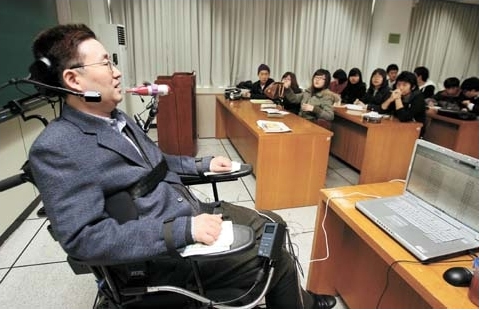
The scene was reminiscent of a Stephen Hawking classroom.
Addressing his students at Seoul National University, Professor Lee Sang-mook, sitting motionless in a wheelchair, busily blew in and out through a straw that allowed him to move a computer mouse. Lee, who teaches marine geophysics and geodynamics at the school, was unable to move and tied to the wheelchair, but his lecture, “Exploration of the Sea,” was dynamic.
Due to a disastrous traffic accident, Lee was left paralyzed below the neck. But just one year later, in August 2007, his determination allowed him to return to the classroom; yesterday marked his first class for the spring semester.
“I totally forgot about my professor’s physical condition while I was listening to the class,” So Byeong-dal, 25, said after the class. “The lecture itself was inspiring, but what motivated me was the realization that I am blessed with my health.”
In July 2006, the car Lee was driving overturned on an uneven dirt road 257 kilometers (160 miles) north of Los Angeles, as he returned to a hotel after completing a geological survey. Lee, in a coma, was taken to a local hospital. Three days later he regained consciousness only to find that he could no longer move.
His dire condition was not an insurmountable obstacle for the 46-year-old scientist. “I call myself a recycled human being,” Lee told the JoongAng Ilbo, saying he was given a second chance in life.
Determined to return to teaching, Lee entered a rehabilitation facility in Los Angeles where doctors taught him how to use dozens of pieces of equipment and software that he can operate with only his breath. Using these tools, Lee realized he could still lecture students. It took three months of training before Lee was ready to return home.
Away from the care in Los Angeles, reality set in when he came back to Seoul. No one thought that he could teach again, he recalled, and he received little encouragement.
But he made it. He returned to work in January 2007 and resumed his studies in preparation for teaching again.
Lee said he also spent time to continue his training on the equipment he uses to communicate. For yesterday’s presentation, Lee spent nine hours setting up his computer.
Lee said his hero is actor Christopher Reeve, the movie Superman who fell from a horse and became paralyzed in 1995. Before he died in 2004, the actor established a foundation to help the disabled and became an outspoken advocate for the rights of the handicapped. Even though Lee cannot donate big money like Reeve, he has a plan to teach disabled people here about what he learned in the United States.
“What the disabled need is not a stem cell cure, but realistic IT technology,” Lee said. “Computer gear and communication software only costs 3 million won [$3,195]. I want to become a superman for those suffering from disabilities because they do not know about the technology.”
SNU NOW
News
News
Professor Won't Let Paralysis End His Life
Apr 02, 2008

